Gigabyte GA-X79-UD3 Review
by Ian Cutress on December 26, 2011 4:37 PM EST- Posted in
- Motherboards
- Gigabyte
- X79
- Sandy Bridge E
USB Speed
For this benchmark, we run CrystalDiskMark to determine the ideal sequential read and write speeds for the USB port using our 64GB Patriot SuperSpeed USB 3.0 drive. Then we transfer a set size of files from the SSD to the USB drive, and monitor the time taken to transfer. The files transferred are a 1.52 GB set of 2867 files across 320 folders – 95% of these files are small typical website files, and the rest (90% of the size) are the videos used in the Sorenson Squeeze test.
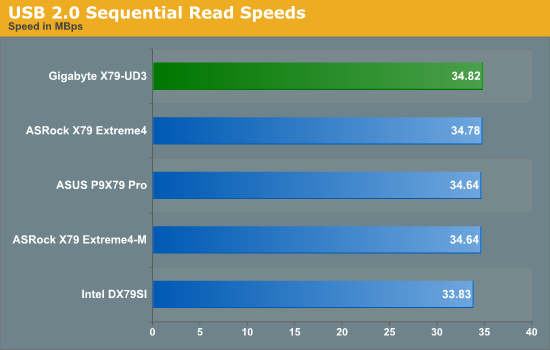

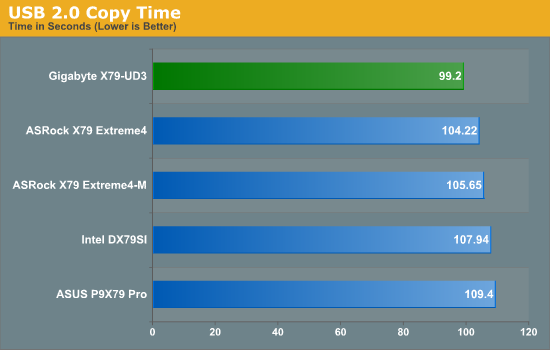
By default, one of the Gigabyte's best showings is in the USB 2.0 tests. It comprehensively is ahead, especially in the USB copy test. Unfortunately, with my USB 3.0 device and the Gigabyte's USB 3.0 Fresco controller, there were compatibility issues preventing any USB 3.0 testing. Should we get a driver update, we will update the graphs.
SATA Testing
We also use CrystalDiskMark for SATA port testing. The operating system is installed on the SSD, and the sequential test is run at the 5 x 1000 MB level. This test probes the efficiency of the data delivery system between the chipset and the drive, or in the case of additional SATA ports provided by a third party controller, the efficiency between the controller, the chipset and the drive.
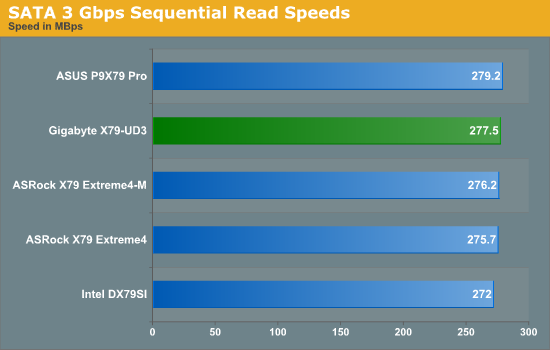
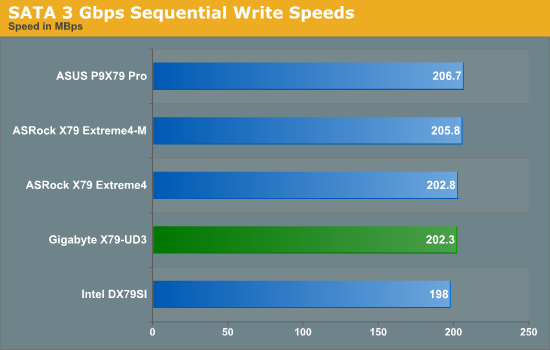

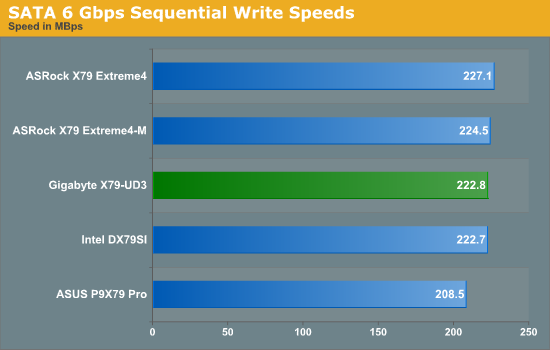
SATA testing of the PCH ports reveals nothing special, with the Gigabyte UD3 being in the middle of the road on average.
DPC Latency
Deferred Procedure Call latency is a way in which Windows handles interrupt servicing. In order to wait for a processor to acknowledge the request, the system will queue all interrupt requests by priority. Critical interrupts will be handled as soon as possible, whereas lesser priority requests, such as audio, will be further down the line. So if the audio device requires data, it will have to wait until the request is processed before the buffer is filled. If the device drivers of higher priority components in a system are poorly implemented, this can cause delays in request scheduling and process time, resulting in an empty audio buffer – this leads to characteristic audible pauses, pops and clicks. Having a bigger buffer and correctly implemented system drivers obviously helps in this regard. The DPC latency checker measures how much time is processing DPCs from driver invocation – the lower the value will result in better audio transfer at smaller buffer sizes. Results are measured in microseconds and taken as the peak latency while cycling through a series of short HD videos - under 500 microseconds usually gets the green light, but the lower the better.

By far one of the best results we had with the Gigabyte board is the DPC testing, where it beat our previous best (an ASUS P8P67) by 25+ microseconds. Getting a score of 70 microseconds is indicative of very clever driver and BIOS programming. However, as with many boards we've seen for X79, to get this result, any voltage/fan monitoring software must be turned off - in this case, EasyTune6.










39 Comments
View All Comments
ComputerGuy2006 - Monday, December 26, 2011 - link
Why do most motherboards on this "high end chipset" that cost 200-500$ tend to only have a single NIC... Its pathetic.The overall LGA 2011 boards are so lame for their price I did not even bother buying a new PC. I now plan on just buying a low end chipset/cpu (ivy bridge) and just paying for an extra NIC...
Metaluna - Monday, December 26, 2011 - link
At least it's not Realtek. I'll take one Intel NIC over two Realtek's any day.Tchamber - Monday, December 26, 2011 - link
I have a desktop, 2 laptops networked with my brother's desktop, and i don't use the two ethernet ports on my desktop, wifi for network and gigabit ethernet for file transfers to/from laptops. What else is it for?Iketh - Tuesday, December 27, 2011 - link
what?cactusdog - Tuesday, December 27, 2011 - link
Haha This board has been recalled why is it even here?? It has a problem with Mosfets exploding.shatteredx - Monday, December 26, 2011 - link
I would assume that purchasers of high-end motherboards already have a router with gigabit ports, so what's the point of having 2 NICs?Another thing: people rave about the quality of Intel NICs over brands like Realtek, but I've owned both and they both performed identically (from what I observed). In fact, I would say that the Realtek NIC has a big advantage over the Intel NIC: Windows 7 can install the Realtek NIC with no driver CD but has no built-in drivers for the Intel one. This could potentially be very inconvenient the next time I reinstall Windows and can't find my mobo CD.
Metaluna - Monday, December 26, 2011 - link
Realtek's drivers seem to have improved recently (especially in the Win7 era), but they have developed a reputation over the years for unreliability and inconsistent performance, especially under heavy loads. I found this out the hard way a few years ago when I installed a new home file server capable of saturating a gigabit link. Suddenly, several of the PCs on my home network (including the file server itself) started dropping off the network erratically, especially during large file copies. After at least a month tearing my hair out, I finally took a shot in the dark and put an Intel NIC in the server, and the problem vanished. The server's network port never went down again, but a couple of the clients were still having problems. I replaced those NICs as well, and suddenly I had a network again. The common thread? All the failing machines had Realtek 8111C/D chips. Remarkably the failures were consistent across different revisions of the Windows driver, and even different OS'es (Server 2003/WHS, XP, Win7)I think the reason people go with Intel is because they're about the only other option available on the market anymore. You used to see motherboards with Marvell, Broadcom, or Atheros NICs, but Realtek pretty much killed them off, and even most of the add-in PCIe cards have gone Realtek, so Intel is really the only alternative if you want to try something different. But it's pretty telling that server motherboards from the likes of Intel, Supermicro, and even Asus never use Realtek (except possibly for the IPMI port). So I'm glad to see Intel trickling back into some of the high end consumer boards.
Ryan Smith - Tuesday, December 27, 2011 - link
You still see Marvell in mobos now and then. The EVGA X79 SLI we use on the GPU testbed has a Marvell 88E8059.Stuka87 - Tuesday, December 27, 2011 - link
I have done some pretty extensive performance test with various NIC's out there. For basic day to day use, there is no difference. But when you start cranking up the frames per second (total throughput means nothing really, has a lot more to do with frames per second), many of the "other" brands (Broadcom and Realtec for instance) cannot stand side bys ide with most Intel NIC's. Although there are some Intel's that are not very good either.However, the point of two NIC' has nothing to do with speed typically. Yes you can bond them together, which is awesome if you are running a lot of VM's off a NAS. But its also very handy if you are on two separate networks.
Oh, and Windows 7 does have built in drivers for Intel NIC's. Where id you see otherwise? Granted they are older ones, just as the other NIC drivers are. But they function fine until you can get the latest.
Metaluna - Wednesday, December 28, 2011 - link
Sandy Bridge boards mostly are using the new Intel 82579V chip, which from what I've read is different enough that the generic Intel e1000 drivers won't always work with it. This has been an issue with some OSes like FreeBSD 8 and VMware ESXi 5 (not sure about Linux distros).My Asus P8Z68-V uses this chip, but unfortunately I can't remember if Win7 supported it out of the box or not.